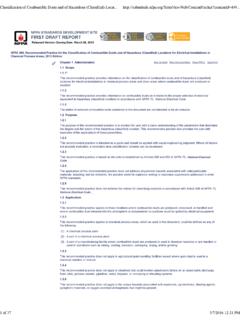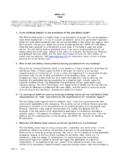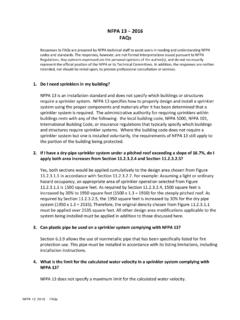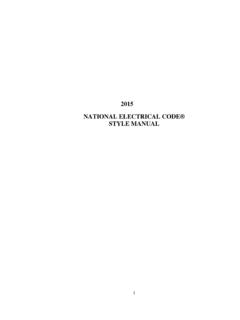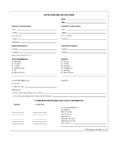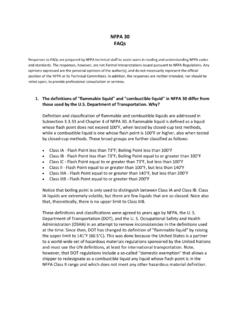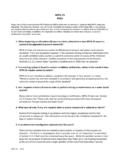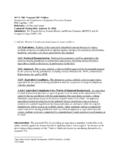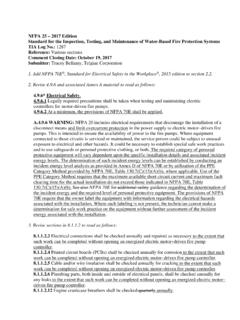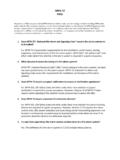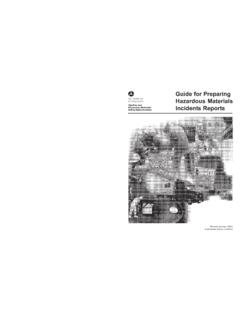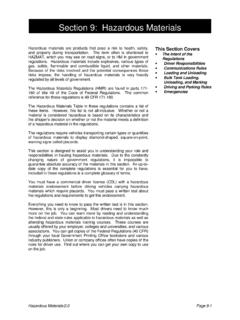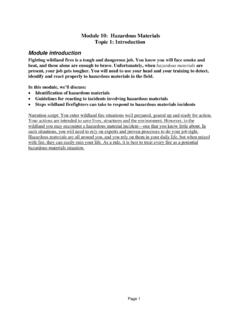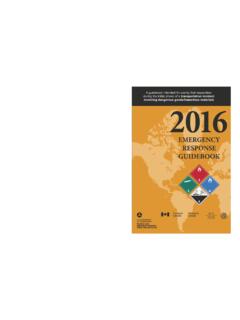Transcription of Fire Hazard Assessment of Lead-Acid Batteries - NFPA
1 TECHNICAL NOTES. Fire Hazard Assessment of Lead-Acid Batteries Final Report by: Trent Parker, Larissa Obeng and Qingsheng Wang, PhD, PE, CSP. Mary Kay O'Connor Process Safety Center Artie McFerrin Department of Chemical Engineering Texas A&M University, College Station, Texas, USA. July 2020. 2020 Fire Protection Research Foundation 1 Batterymarch Park, Quincy, MA 02169, USA | Web: | Email: Page ii . Foreword Several nfpa standards, such as nfpa 1, 75, 76, 111 and 855 address the fire resistance of large-scale battery deployments. Some, such as nfpa 855 request large-scale fire testing when installations exceed the maximum allowable quantities in the codes and standards. Lead-Acid Batteries have had a long history of use in the telecommunications industry, data centers, nuclear industries, power industries, among others.
2 Since many of these battery chemistries are now being regulated by the same standards, a better understanding of the fire risks associated with Lead-Acid Batteries was needed for use as a comparison to other battery chemistries. The Fire Protection Research Foundation expresses gratitude to the report authors Trent Parker, Larissa Obeng and Qingsheng Wang, , PE, CSP, who are with Texas A&M University Mary Kay O'Connor Process Safety Center, Artie McFerrin Department of Chemical Engineering located in College Station, Texas. The Research Foundation appreciates the guidance provided by the Project Technical Panelists and all others that contributed to this research effort. Thanks are also expressed to the National Fire Protection Association ( nfpa ) for providing the project funding through the nfpa Annual Research Fund.
3 The content, opinions and conclusions contained in this report are solely those of the authors and do not necessarily represent the views of the Fire Protection Research Foundation, nfpa , Technical Panel or Sponsors. The Foundation makes no guaranty or warranty as to the accuracy or completeness of any information published herein. About the Fire Protection Research Foundation The Fire Protection Research Foundation plans, manages, and communicates research on a broad range of fire safety issues in collaboration with scientists and laboratories around the world. The Foundation is an affiliate of nfpa . About the National Fire Protection Association ( nfpa ). Founded in 1896, nfpa is a global, nonprofit organization devoted to eliminating death, injury, property and economic loss due to fire, electrical and related hazards.
4 The association delivers information and knowledge through more than 300 consensus codes and standards, research, training, education, outreach and advocacy; and by partnering with others who share an interest in furthering the nfpa mission. All nfpa codes and standards can be viewed online for free. nfpa 's membership totals more than 65,000 individuals around the world. Keywords: Batteries , Lead-Acid , flooded Lead-Acid , valve-regulated lead acid, fire Hazard , risk Report number: FPRF-2020-08-REV. Project Manager: Victoria Hutchison Page iii . Project Technical Panel Jeffery Betz, AT&T. Jim Biggins, T V S D Global Risk Consultants Richard Kluge, Ericsson Brian O'Connor, nfpa . Paul Rogers, PGR Group, LLC. Project Sponsors National Fire Protection Association Page iv.
5 Fire Hazard Assessment of Lead-Acid Battery Chemistries Trent Parker, Graduate Student Larissa Obeng, Undergraduate Student Dr. Qingsheng Wang, PE, CSP, Associate Professor Mary Kay O'Connor Process Safety Center Artie McFerrin Department of Chemical Engineering Texas A&M University Date: June 20, 2020. 1. Executive Summary In recent years, lead acid Batteries have been replaced by lithium ion Batteries in many applications. This is a result of the lithium ion Batteries having a greater energy density, efficiency, and lifespan as compared to lead acid battery chemistries. These Batteries , however, are capable of storing large amounts of energy and often utilize a volatile or combustible electrolyte and thus are prone to fires and explosions. As a result, significant testing has been conducted to identify the fire hazards associated with lithium ion Batteries .
6 However, little testing has been performed on the lead acid battery chemistries. Thus, in this work, fire hazards associated with lead acid Batteries are identified both from a review of incidents involving them and from available fire test information. From this, it is determined that lead acid Batteries present low fire risks. 2. Table of Contents Executive Summary 2. List of Tables 3. List of Figures 3. Introduction 4. Fire Incidents 5. Fire Testing 7. Results 7. Stationary Device Incidents 8. Mobile Device Incidents 10. Fire Testing 13. Discussion 13. Conclusions 14. References 15. List of Tables Table 1: Battery Type Advantages and Disadvantages 4. Table 2: Stationary Lead-Acid Battery Incidents 8. Table 3: Mobile Lead-Acid Battery Incidents 10. Table 4: Lead-Acid Battery Fire Test Data 13.
7 List of Figures Figure 1: Lead-Acid Battery Diagram 4. 3. Introduction Lead acid Batteries were invented in 1859 and were the earliest type of rechargeable Batteries to be used in commercial applications. They consist of flat plates submerged in a dilute electrolytic solution containing sulfuric acid (H2SO4), with the anodes consisting of lead dioxide plates and the cathodes consisting of lead plates, as shown in Figure 1. Figure 1: Lead-Acid Battery Diagram In order for the battery to store energy, the sulfuric acid triggers chemical reactions within the plates in order to produce electrons, which generate the electricity4. As these reactions are reversible, the battery can be used for the duration of its life. The lead acid Batteries are divided into two categories, flooded and valve-regulated lead acid (VRLA).
8 In flooded cell Batteries , there is an excess of electrolyte fluid, resulting in the lead plates being completely submerged. In VRLA Batteries , however, the electrolyte is immobilized, with excess oxygen and hydrogen built up in the battery vented out with a vent or valve. Advantages and disadvantages of VRLA. and flooded lead acid Batteries are presented in Table 1. Table 1: Battery Type Advantages and Disadvantages Flooded Batteries VRLA Batteries Advantages Disadvantages Advantages Disadvantages -Less Costly -Possible Leakage -Electrolyte Spillage -More Costly -Longer Lifespans -More Ventilation Not Possible -Do Not Tolerate Space Required -Little Maintenance Overcharging Required 4. Lead acid Batteries are used in a wide range of applications, including automotive, uninterruptible power supply (UPS), telecom, electric bikes, and transport vehicles.
9 In 2019, the global market for lead acid Batteries was valued at $ billion. Within this market, the VRLA segment held a market share and the flooded battery segment held a market share10. Automotive was the largest application segment in terms of revenue share. Within the US, there were approximately million vehicles in use in 2019, with 93% of them using lead acid Batteries , resulting in approximately 260 million lead acid Batteries in automotive applications in the US. In recent years, lithium ion Batteries have become widely used as a result of having greater energy density, efficiency, depth of discharge, and lifespan as compared to lead acid battery chemistries. However, as lithium ion Batteries can generate large amounts of energy and often contain a volatile or combustible electrolyte, they are susceptible to an increased frequency of fires and explosions.
10 Because of this, much research has been conducted in recent years regarding the fire hazards associated with lithium ion battery chemistries. Publicly available research on the fire hazards associated with Lead-Acid battery chemistries is limited, including resources such as fire test data and fire incident reports. Fire test data can be used to determine the potential for thermal runaway, defined as a thermal reaction where the internal heat generation exceeds the rate at which heat can be dissipated, leading to a thermal reaction such as fire. According to the available literature, VRLA Batteries are more prone to thermal runaway than flooded lead acid batteries5. While this study did not investigate the effects of the battery materials, including the casing and battery design, this report focuses on identifying and analyzing the fire hazards associated with lead acid battery chemistries through a review of relevant fire incidents and results of fire testing.
